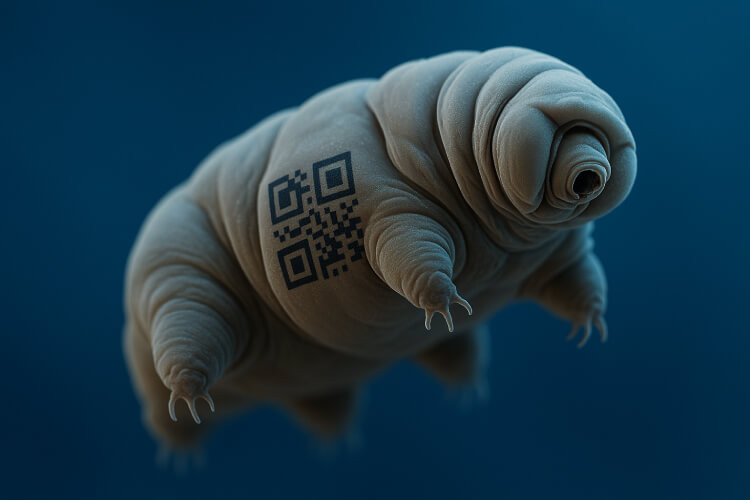Tattooing Tardigrades with Nanotech for Living Devices
Insights | 17-06-2025 | By Robin Mitchell

Key Takeaways:
- Researchers tattooed living tardigrades using ice lithography — a biocompatible nanofabrication process demonstrating unprecedented precision at the microscale.
- This technique may enable next-gen biodevices — potential applications include microbial sensors, bio-integrated electronics, and cell-level diagnostics.
- Micro-tattoos survived extreme conditions — demonstrating the potential for embedding nanotechnology into living organisms without disrupting viability or behaviour.
- Study advances personalised medicine prospects — opening pathways to tagging individual human cells or engineering microbial cyborgs for targeted therapies.
While the promise of multifunctional nanodevices has long captured the imagination of scientists and sci-fi fans alike, the reality of building such systems remains riddled with challenges. From fabrication incompatibilities to the unpredictable behaviour of materials at the nanoscale, the hurdles are as intricate as the technologies themselves.
Recently, however, researchers at the Technical University of Denmark have taken a surprising step forward, not by building a complex nanomachine, but by successfully "tattooing" living tardigrades using a refined nanofabrication process.
So, what makes this feat possible, how does it advance the field of nanotechnology, and what could this mean for future bio-integrated devices?
The Challenges With Nano Tech
Over the past decade, researchers have made some truly remarkable progress in the field of nanotechnologies. We've seen developments that would've sounded like science fiction not that long ago, MEMS (Micro-Electro-Mechanical Systems) devices smaller than a grain of sand that can detect the slightest vibrations and miniaturised gas sensors so sensitive they can effectively "sniff" the surrounding air like a bloodhound.
Each of these technologies, on its own, is a masterclass in precision engineering. The ability to fabricate, power, and process data from structures measured in nanometers is no small achievement. Engineers and scientists have repeatedly shown that we can build incredibly specialised, reliable nanodevices when we focus on doing one thing well.
However, the real dream-the one you always see hyped up in media clips or TED Talks-is something far grander: combining these tiny marvels into single, multifunctional nanodevices. Think nano-robots that swim through your bloodstream detecting diseases and repairing tissues at a cellular level. A beautiful vision... but right now, it remains just that, a vision. Not a reality.
The Multifunctional Nanodevice Challenge
The reasons for this are plenty, and they're deeply rooted in the fundamental challenges of physics, chemistry, and manufacturing at the nanoscale. First off, combining different manufacturing processes is a nightmare. Each sensor type, whether it's a vibration detector, a chemical sniffer, or a pressure monitor, often requires a totally different fabrication method, different base materials, and different post-processing techniques.
Then there's the issue of chemically and mechanically binding and manipulating these tiny objects, where forces don't behave the way they do at the macro scale. Adhesion, stiction, and electrostatic forces dominate, and simple actions like moving a component without it sticking permanently to something else become enormously complicated.
Nanoscale Limitations and Manufacturing Realities
And let's not forget about yield. Building anything at the nanoscale inevitably results in manufacturing errors. When you're trying to assemble billions of devices, even a 0.01% failure rate can render the whole batch useless. High-precision manufacturing doesn't scale easily to the nanoworld, and nature isn't exactly giving us shortcuts.
The net result? Despite all the hype, creating tiny, fully autonomous nano-robots capable of complex tasks, like patrolling your arteries for cholesterol buildup, remains more of a fantasy than a near-future reality. That's not to discredit the incredible work being done; we are laying the groundwork for a nanotech future.
Progress is happening, and it's worth celebrating. But it's happening one focused, functional nanodevice at a time, not through the sudden emergence of microscopic Swiss Army knives.
Scientists Successfully "Tattoo" Tardigrades in Breakthrough Nanotechnology Development
In a remarkable achievement in the field of nanotechnology, a team of researchers from the Technical University of Denmark has successfully "tattooed" tiny patterns onto the bodies of living tardigrade organisms. The breakthrough, published in the journal Nano Letters, demonstrates a new technique for creating biocompatible devices at the nanoscale, with potential applications in fields such as biomedical sensing and living microrobotic systems.
The procedure involved placing the tardigrades in a cryptobiotic state, coating them with a protective anisole layer, and then using an electron beam to generate nanoscale patterns. According to the original ACS report, these “tattoos” survived the process due to the anisole's biocompatibility, reacting only under specific conditions. The precision enabled designs as fine as 72 nanometres across, suggesting future applications for ultra-small, biocompatible devices etched directly onto living systems.
Refining Ice Lithography for Biocompatible Micro-Patterning
The researchers, led by optical engineer Ding Zhao, adapted an existing nanofabrication technique known as ice lithography to create the tiny tattoos. This process involves firing a beam of electrons at a target surface to etch a nanometer-scale pattern. To prevent contamination and damage, the researchers used a thin layer of ice as a protective barrier between the electron beam and the surface.
The team began by inducing a state of cryptobiosis, or suspended metabolism, in the tardigrades, which allowed them to survive extreme conditions such as freezing and boiling. The tardigrades were then stored in a vacuum chamber, where they were exposed to the electron beam and the protective ice layer. After the process, the tardigrades were rehydrated and allowed to revive, with 40% of the animals surviving the procedure and displaying their new tattoos.
The survival rate of 40% might appear modest, but researchers consider this a strong baseline for optimisation. With careful refinement, they anticipate higher viability in future iterations, especially when extending this approach to organisms with less extreme survival capabilities than tardigrades.
The ability to create micro/nanopatterned devices on living organisms presents a significant opportunity for the development of new technologies. The researchers believe that their technique could be adapted for use with other organisms, such as bacteria, and may also have applications in the field of microbial sensing.
Expanding Applications Beyond Tardigrades
One co-author of the study, Ding Zhao, remarked, “We’re not just creating micro-tattoos on tardigrades — we’re extending this capability to various living organisms, including bacteria.” This statement signals a shift in how nanotechnology could be embedded across biological domains, particularly in areas such as targeted diagnostics or microbial tracking within complex environments.
"The integration of more micro/nano fabrication techniques with biologically relevant micro/nanofabricated systems will further advance fields such a microbial sensing, biomimetics, and living microrobotics," the researchers wrote in their paper.
The use of nanofabrication techniques in living organisms also raises interesting questions about the potential for creating living biodevices. While the researchers have only demonstrated the ability to create tiny patterns on tardigrades, the concept of creating living devices that can interact with their environment and respond to stimuli is not far-fetched.
Micro-patterning techniques such as these may also play a role in enabling so-called microbial cyborgs—hybrid systems where electronic components interface with living cells. As noted by independent researcher Gavin King, this work “portends a new generation of biomaterial devices and biophysical sensors that were previously only present in science fiction.”
Could These Nano Tattoos Open the Doors to New Ideas?
Frankly, the fact that scientists managed to tattoo tardigrades doesn't exactly blow my mind. When you consider that these tiny "water bears" can survive in outer space, shrug off boiling water, and laugh in the face of radiation, it's hardly surprising they could handle a little ice-assisted nanofabrication. If anything, I'm more surprised it took this long for someone to try it.
What is interesting, though, is what this research points toward: the expansion of nano-tattooing techniques beyond just the world's toughest microorganisms. This could open doors to applications far more significant than giving tardigrades a cosmetic makeover.
Expanding Applications Beyond Tardigrades
One obvious idea is nano-tattooing individual human cells. Imagine being able to mark specific cells, such as cancer cells, and track their spread in real-time. Or tagging cells during treatment trials to monitor exactly which therapies a specific cell population responds to. Since cells tend to behave differently when in isolation versus when they're part of a larger tissue network, having the ability to uniquely identify and monitor individual cells could absolutely revolutionise medical testing and drug development.
The technology’s foundation in ice lithography, combined with the durability of organisms like tardigrades, offers a compelling testbed for future development. If similar patterning techniques can be translated to human-compatible tissues, the implications for personalised medicine and cellular monitoring could be substantial.
Toward Functional Integration in Living Systems
Of course, there's a whole other side to this, too, one that's squarely in the wheelhouse of nanotechnology and bioengineering. Applying tiny electronic systems to living organisms could become a practical reality. Picture a genetically modified tardigrade, purpose-built to hunt down cancer cells or deliver targeted therapies, carrying a nanoscopic serial number tattooed onto its body. That serial number could carry metadata: when it was modified, what genetic tweaks it carries, and how it's expected to behave. In complex biological systems where traceability and version control are critical, something like that could be a game-changer.
Now, these ideas are still way down the road. Tardigrade tattoos are a stepping stone, not the final product. Engineering living organisms at that level of precision is still a fantasy that needs a whole lot more research and real-world testing before it becomes feasible.
But the bottom line is this: being able to nano-tattoo living organisms and have a decent survival rate afterwards is a huge technical flex. And it makes tardigrades, already some of the coolest creatures on the planet, even cooler.

